load capacity Seat Alhambra 2018 Owner's Manual
[x] Cancel search | Manufacturer: SEAT, Model Year: 2018, Model line: Alhambra, Model: Seat Alhambra 2018Pages: 324, PDF Size: 7.04 MB
Page 154 of 324
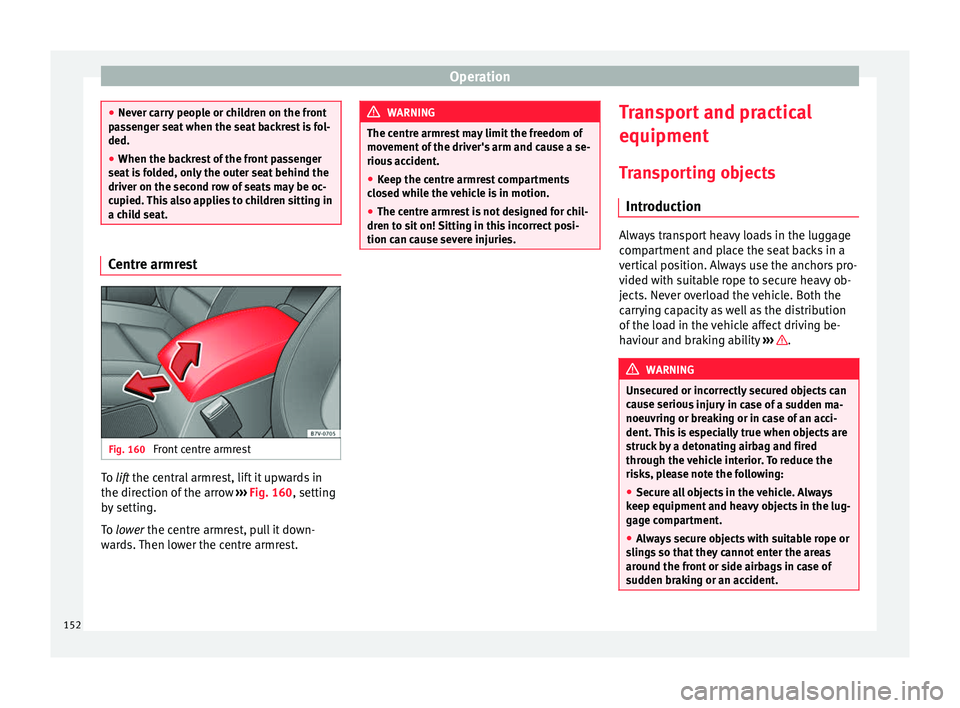
Operation
●
Never c arr
y people or children on the front
passenger seat when the seat backrest is fol-
ded.
● When the backrest of the front passenger
seat i
s folded, only the outer seat behind the
driver on the second row of seats may be oc-
cupied. This also applies to children sitting in
a child seat. Centre armrest
Fig. 160
Front centre armrest To lif
t the central armrest, lift it upwards in
the dir ection of
the arrow ››› Fig. 160, setting
by setting.
To lower the centre armrest, pull it down-
wards. Then lower the centre armrest. WARNING
The centre armrest may limit the freedom of
mov ement
of the driver's arm and cause a se-
rious accident.
● Keep the centre armrest compartments
closed whi
le the vehicle is in motion.
● The centre armrest is not designed for chil-
dren to s
it on! Sitting in this incorrect posi-
tion can cause severe injuries. Transport and practical
equipment
T r
an
sporting objects
Introduction Always transport heavy loads in the luggage
comp
ar
tment and place the seat backs in a
vertical position. Always use the anchors pro-
vided with suitable rope to secure heavy ob-
jects. Never overload the vehicle. Both the
carrying capacity as well as the distribution
of the load in the vehicle affect driving be-
haviour and braking ability ››› .
WARNING
Unsecured or incorrectly secured objects can
cau se seriou
s injury in case of a sudden ma-
noeuvring or breaking or in case of an acci-
dent. This is especially true when objects are
struck by a detonating airbag and fired
through the vehicle interior. To reduce the
risks, please note the following:
● Secure all objects in the vehicle. Always
keep equipment and he
avy objects in the lug-
gage compartment.
● Always secure objects with suitable rope or
sling
s so that they cannot enter the areas
around the front or side airbags in case of
sudden braking or an accident. 152
Page 156 of 324
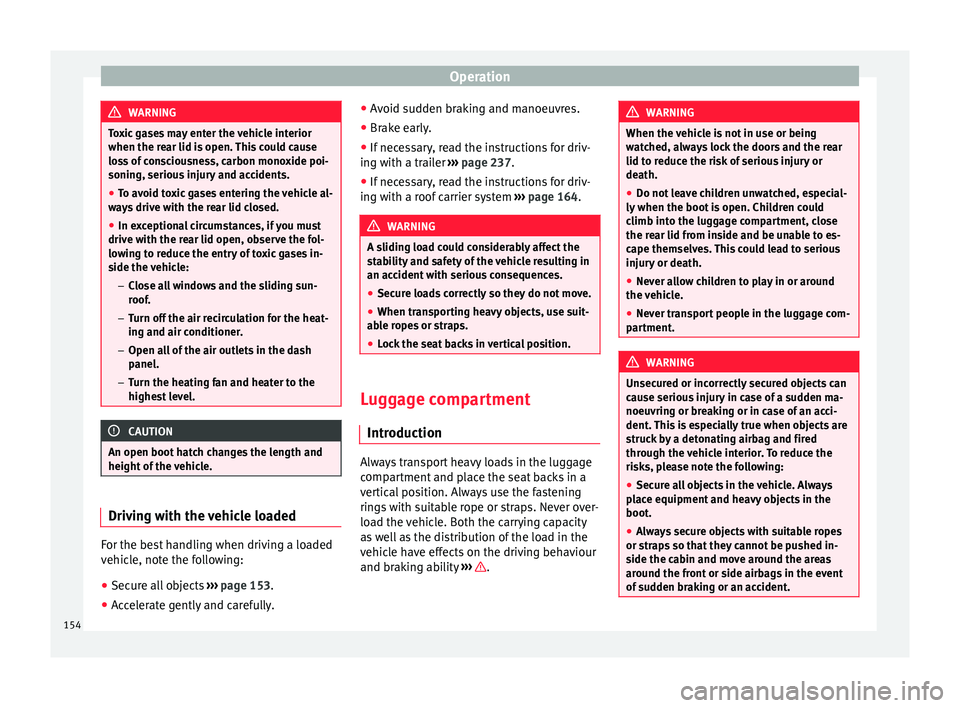
Operation
WARNING
Toxic gases may enter the vehicle interior
when the re ar lid i
s open. This could cause
loss of consciousness, carbon monoxide poi-
soning, serious injury and accidents.
● To avoid toxic gases entering the vehicle al-
way
s drive with the rear lid closed.
● In exceptional circumstances, if you must
drive with the r
ear lid open, observe the fol-
lowing to reduce the entry of toxic gases in-
side the vehicle:
– Close all windows and the sliding sun-
roof.
– Turn off the air recirculation for the heat-
ing and air conditioner.
– Open all of the air outlets in the dash
panel.
– Turn the heating fan and heater to the
highest level. CAUTION
An open boot hatch changes the length and
height of the
vehicle.Driving with the vehicle loaded
For the best handling when driving a loaded
v
ehic
l
e, note the following:
● Secure all objects ›››
page 153.
● Accelerate gently and carefully. ●
Avoid s
udden braking and manoeuvres.
● Brake early.
● If necessary, read the instructions for driv-
ing with a tr
ailer ››› page 237.
● If necessary, read the instructions for driv-
ing with a r
oof carrier system ››› page 164. WARNING
A sliding load could considerably affect the
st ab
ility and safety of the vehicle resulting in
an accident with serious consequences.
● Secure loads correctly so they do not move.
● When transporting heavy objects, use suit-
able r
opes or straps.
● Lock the seat backs in vertical position. Luggage compartment
Intr oduction Always transport heavy loads in the luggage
c
omp
ar
tment and place the seat backs in a
vertical position. Always use the fastening
rings with suitable rope or straps. Never over-
load the vehicle. Both the carrying capacity
as well as the distribution of the load in the
vehicle have effects on the driving behaviour
and braking ability ››› . WARNING
When the vehicle is not in use or being
wat c
hed, always lock the doors and the rear
lid to reduce the risk of serious injury or
death.
● Do not leave children unwatched, especial-
ly when the boot i
s open. Children could
climb into the luggage compartment, close
the rear lid from inside and be unable to es-
cape themselves. This could lead to serious
injury or death.
● Never allow children to play in or around
the vehic
le.
● Never transport people in the luggage com-
partment
. WARNING
Unsecured or incorrectly secured objects can
cau se seriou
s injury in case of a sudden ma-
noeuvring or breaking or in case of an acci-
dent. This is especially true when objects are
struck by a detonating airbag and fired
through the vehicle interior. To reduce the
risks, please note the following:
● Secure all objects in the vehicle. Always
plac
e equipment and heavy objects in the
boot.
● Always secure objects with suitable ropes
or strap
s so that they cannot be pushed in-
side the cabin and move around the areas
around the front or side airbags in the event
of sudden braking or an accident. 154
Page 167 of 324
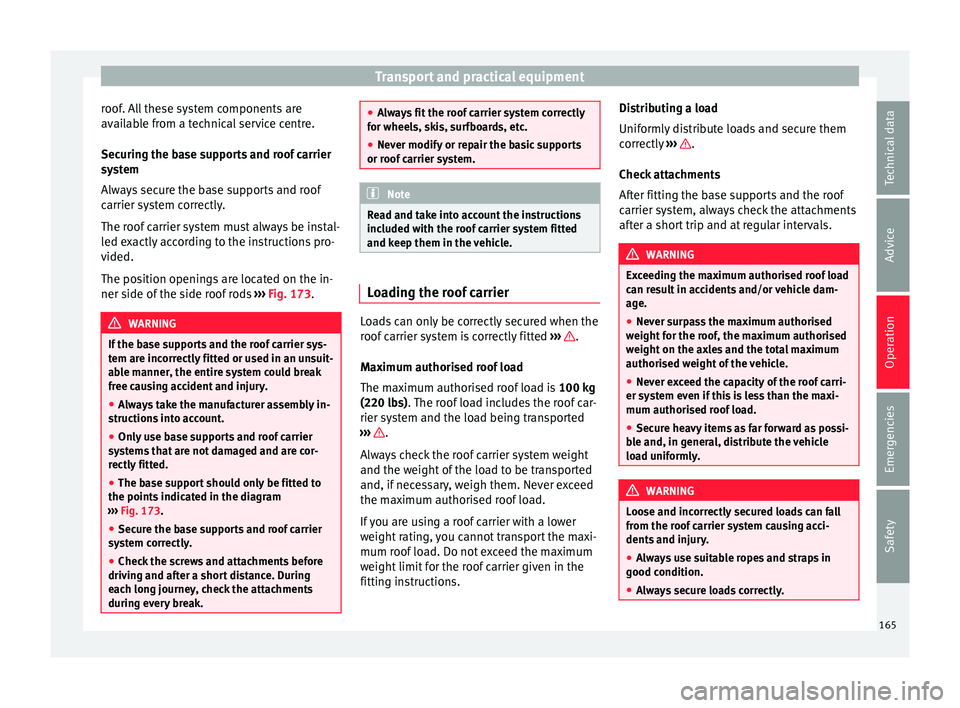
Transport and practical equipment
roof. All these system components are
av ai
l
able from a technical service centre.
Securing the base supports and roof carrier
system
Always secure the base supports and roof
carrier system correctly.
The roof carrier system must always be instal-
led exactly according to the instructions pro-
vided.
The position openings are located on the in-
ner side of the side roof rods ››› Fig. 173. WARNING
If the base supports and the roof carrier sys-
tem ar e inc
orrectly fitted or used in an unsuit-
able manner, the entire system could break
free causing accident and injury.
● Always take the manufacturer assembly in-
structions
into account.
● Only use base supports and roof carrier
syst
ems that are not damaged and are cor-
rectly fitted.
● The base support should only be fitted to
the points indic
ated in the diagram
››› Fig. 173.
● Secure the base supports and roof carrier
syst
em correctly.
● Check the screws and attachments before
driving and af
ter a short distance. During
each long journey, check the attachments
during every break. ●
Alw a
ys fit the roof carrier system correctly
for wheels, skis, surfboards, etc.
● Never modify or repair the basic supports
or roof c
arrier system. Note
Read and take into account the instructions
inc luded w ith the r
oof carrier system fitted
and keep them in the vehicle. Loading the roof carrier
Loads can only be correctly secured when the
r
oof
c
arrier system is correctly fitted ››› .
M ax
imum authori
sed roof load
The maximum authorised roof load is 100 kg
(220 lbs). The roof load includes the roof car-
rier system and the load being transported
››› .
A lw
a
ys check the roof carrier system weight
and the weight of the load to be transported
and, if necessary, weigh them. Never exceed
the maximum authorised roof load.
If you are using a roof carrier with a lower
weight rating, you cannot transport the maxi-
mum roof load. Do not exceed the maximum
weight limit for the roof carrier given in the
fitting instructions. Distributing a load
Uniformly
distribute loads and secure them
correctly ››› .
Chec k
att
achments
After fitting the base supports and the roof
carrier system, always check the attachments
after a short trip and at regular intervals. WARNING
Exceeding the maximum authorised roof load
can r e
sult in accidents and/or vehicle dam-
age.
● Never surpass the maximum authorised
weight f
or the roof, the maximum authorised
weight on the axles and the total maximum
authorised weight of the vehicle.
● Never exceed the capacity of the roof carri-
er syst
em even if this is less than the maxi-
mum authorised roof load.
● Secure heavy items as far forward as possi-
ble and, in g
eneral, distribute the vehicle
load uniformly. WARNING
Loose and incorrectly secured loads can fall
from the r oof
carrier system causing acci-
dents and injury.
● Always use suitable ropes and straps in
good condition.
● A
lways secure loads correctly. 165
Technical data
Advice
Operation
Emergencies
Safety
Page 254 of 324
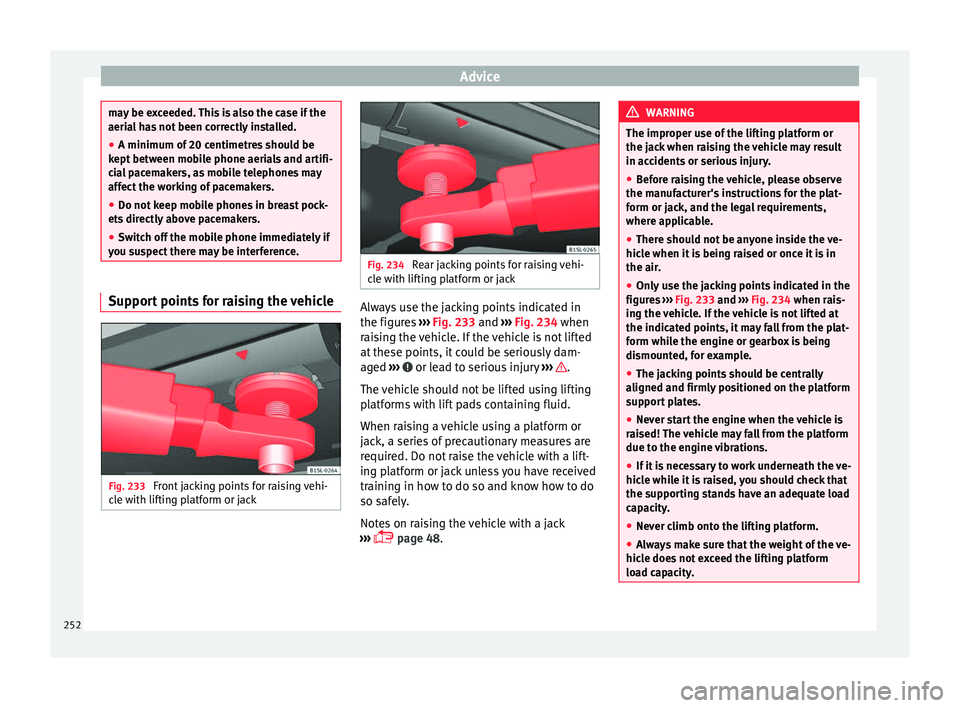
Advice
may be exceeded. This is also the case if the
aeria
l
has not been correctly installed.
● A minimum of 20 centimetres should be
kept betw
een mobile phone aerials and artifi-
cial pacemakers, as mobile telephones may
affect the working of pacemakers.
● Do not keep mobile phones in breast pock-
ets dir
ectly above pacemakers.
● Switch off the mobile phone immediately if
you su
spect there may be interference. Support points for raising the vehicle
Fig. 233
Front jacking points for raising vehi-
c l
e w
ith lifting platform or jack Fig. 234
Rear jacking points for raising vehi-
cl e w
ith lifting platform or jack Always use the jacking points indicated in
the figur
e
s
››› Fig. 233 and ››› Fig. 234 when
raising the vehicle. If the vehicle is not lifted
at these points, it could be seriously dam-
aged ››› or lead to serious injury
››
›
.
The v
ehic
le should not be lifted using lifting
platforms with lift pads containing fluid.
When raising a vehicle using a platform or
jack, a series of precautionary measures are
required. Do not raise the vehicle with a lift-
ing platform or jack unless you have received
training in how to do so and know how to do
so safely.
Notes on raising the vehicle with a jack
››› page 48. WARNING
The improper use of the lifting platform or
the jac k
when raising the vehicle may result
in accidents or serious injury.
● Before raising the vehicle, please observe
the manufact
urer's instructions for the plat-
form or jack, and the legal requirements,
where applicable.
● There should not be anyone inside the ve-
hicle when it
is being raised or once it is in
the air.
● Only use the jacking points indicated in the
figures
››› Fig. 233 and ››› Fig. 234 when rais-
ing the vehicle. If the vehicle is not lifted at
the indicated points, it may fall from the plat-
form while the engine or gearbox is being
dismounted, for example.
● The jacking points should be centrally
aligned and firmly
positioned on the platform
support plates.
● Never start the engine when the vehicle is
raised!
The vehicle may fall from the platform
due to the engine vibrations.
● If it is necessary to work underneath the ve-
hicle whi
le it is raised, you should check that
the supporting stands have an adequate load
capacity.
● Never climb onto the lifting platform.
● Always make sure that the weight of the ve-
hicle doe
s not exceed the lifting platform
load capacity. 252
Page 292 of 324
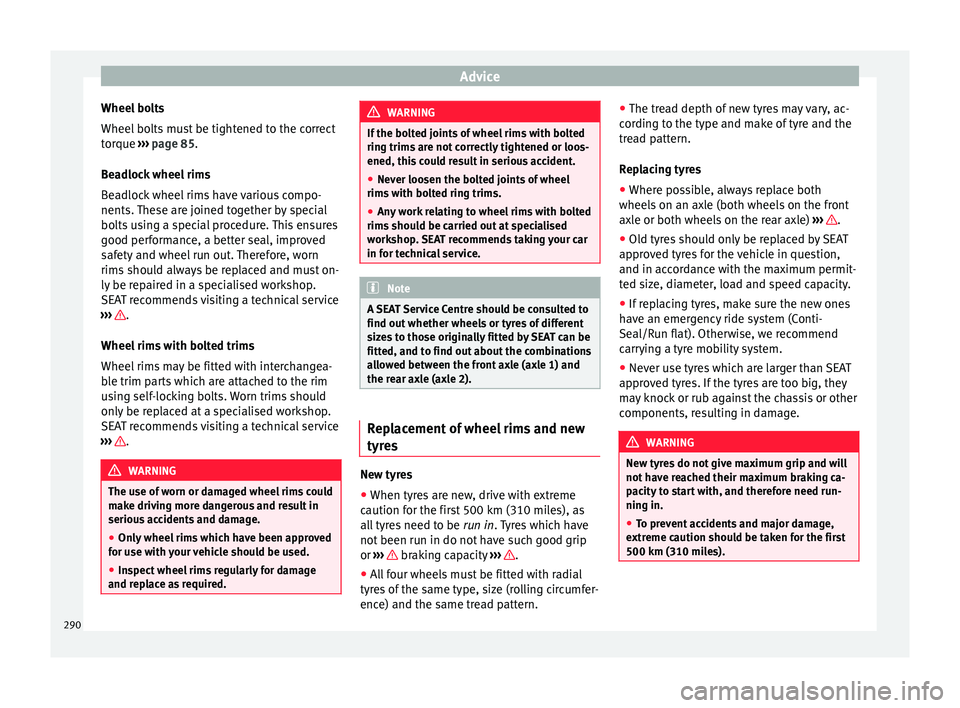
Advice
Wheel bolts
Wheel bo
lts
must be tightened to the correct
torque ››› page 85.
Beadlock wheel rims
Beadlock wheel rims have various compo-
nents. These are joined together by special
bolts using a special procedure. This ensures
good performance, a better seal, improved
safety and wheel run out. Therefore, worn
rims should always be replaced and must on-
ly be repaired in a specialised workshop.
SEAT recommends visiting a technical service
››› .
Wheel rims
w
ith bolted trims
Wheel rims may be fitted with interchangea-
ble trim parts which are attached to the rim
using self-locking bolts. Worn trims should
only be replaced at a specialised workshop.
SEAT recommends visiting a technical service
››› .
WARNING
The use of worn or damaged wheel rims could
mak e driv
ing more dangerous and result in
serious accidents and damage.
● Only wheel rims which have been approved
for use w
ith your vehicle should be used.
● Inspect wheel rims regularly for damage
and repl
ace as required. WARNING
If the bolted joints of wheel rims with bolted
ring trims ar
e not correctly tightened or loos-
ened, this could result in serious accident.
● Never loosen the bolted joints of wheel
rims with bo
lted ring trims.
● Any work relating to wheel rims with bolted
rims shoul
d be carried out at specialised
workshop. SEAT recommends taking your car
in for technical service. Note
A SEAT Service Centre should be consulted to
find out whether wheel s
or tyres of different
sizes to those originally fitted by SEAT can be
fitted, and to find out about the combinations
allowed between the front axle (axle 1) and
the rear axle (axle 2). Replacement of wheel rims and new
ty
r
e
s New tyres
● When tyres are new, drive with extreme
c aution f
or the fir
st 500 km (310 miles), as
all tyres need to be run in. Tyres which have
not been run in do not have such good grip
or ››› braking capacity
››
›
.
● All four wheels must be fitted with radial
ty r
e
s of the same type, size (rolling circumfer-
ence) and the same tread pattern. ●
The trea
d depth of new tyres may vary, ac-
cording to the type and make of tyre and the
tread pattern.
Replacing tyres
● Where possible, always replace both
wheels on an ax
le (both wheels on the front
axle or both wheels on the rear axle) ››› .
● Old tyres should only be replaced by SEAT
ap pr
o
ved tyres for the vehicle in question,
and in accordance with the maximum permit-
ted size, diameter, load and speed capacity.
● If replacing tyres, make sure the new ones
have an emer
gency ride system (Conti-
Seal/Run flat). Otherwise, we recommend
carrying a tyre mobility system.
● Never use tyres which are larger than SEAT
appro
ved tyres. If the tyres are too big, they
may knock or rub against the chassis or other
components, resulting in damage. WARNING
New tyres do not give maximum grip and will
not h av
e reached their maximum braking ca-
pacity to start with, and therefore need run-
ning in.
● To prevent accidents and major damage,
extreme c
aution should be taken for the first
500 km (310 miles). 290
Page 297 of 324
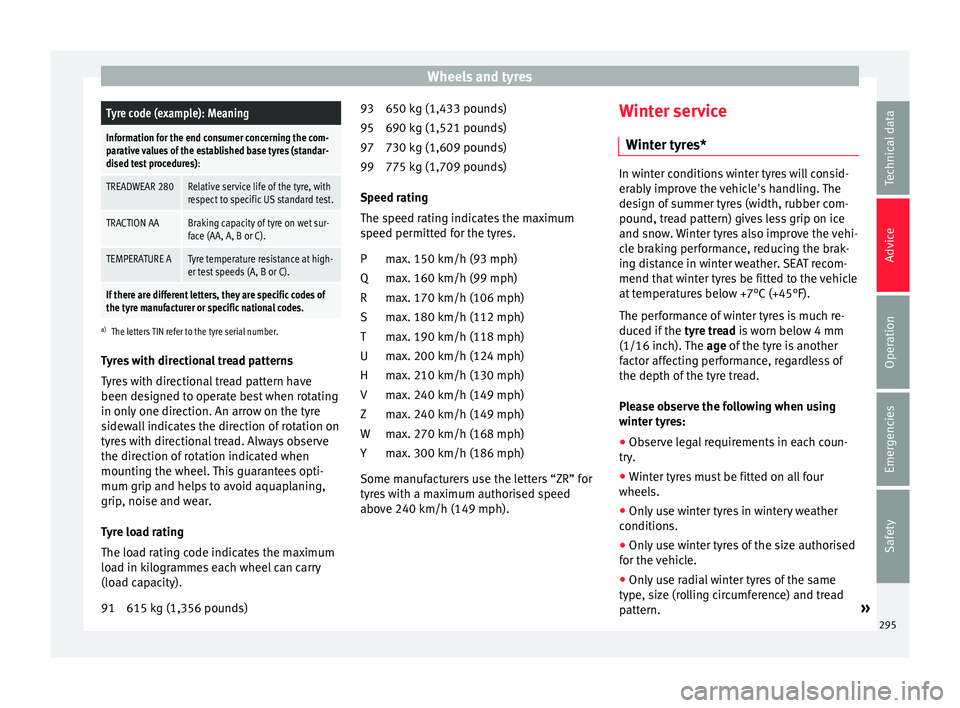
Wheels and tyresTyre code (example): Meaning
Information for the end consumer concerning the com-
parative values of the established base tyres (standar-
dised test procedures)
:
TREADWEAR 280Relative service life of the tyre, with
respect to specific US standard test.
TRACTION AABraking capacity of tyre on wet sur-
face (AA, A, B or C).
TEMPERATURE ATyre temperature resistance at high-
er test speeds (A, B or C).
If there are different letters, they are specific codes of
the tyre manufacturer or specific national codes.
a)
The letters TIN refer to the tyre serial number.
Tyres with directional tread patterns
Tyres with directional tread pattern have
been designed to operate best when rotating
in only one direction. An arrow on the tyre
sidewall indicates the direction of rotation on
tyres with directional tread. Always observe
the direction of rotation indicated when
mounting the wheel. This guarantees opti-
mum grip and helps to avoid aquaplaning,
grip, noise and wear.
Tyre load rating
The load rating code indicates the maximum
load in kilogrammes each wheel can carry
(load capacity).
615 kg (1,356 pounds)
91 650 kg (1,433 pounds)
690 kg (1,521 pound
s)
730 kg (1,609 pounds)
775 kg (1,709 pounds)
Speed rating
The speed rating indicates the maximum
speed permitted for the tyres. max. 150 km/h (93 mph)
max. 160 km/h (99 mph)
max. 170 km/h (106 mph)
max. 180 km/h (112 mph)
max. 190 km/h (118 mph)
max. 200 km/h (124 mph)
max. 210 km/h (130 mph)
max. 240 km/h (149 mph)
max. 240 km/h (149 mph)
max. 270 km/h (168 mph)
max. 300 km/h (186 mph)
Some manufacturers use the letters “ZR” for
tyres with a maximum authorised speed
above 240 km/h (149 mph). 93
95
97
99
P
Q
R
S
T
U
H
V
Z
W
Y Winter service
Winter ty res* In winter conditions winter tyres will consid-
erab
ly
improve the vehicle's handling. The
design of summer tyres (width, rubber com-
pound, tread pattern) gives less grip on ice
and snow. Winter tyres also improve the vehi-
cle braking performance, reducing the brak-
ing distance in winter weather. SEAT recom-
mend that winter tyres be fitted to the vehicle
at temperatures below +7°C (+45°F).
The performance of winter tyres is much re-
duced if the tyre tread is worn below 4 mm
(1/16 inch). The age of the tyre is another
factor affecting performance, regardless of
the depth of the tyre tread.
Please observe the following when using
winter tyres:
● Observe legal requirements in each coun-
try .
● W
inter tyres must be fitted on all four
wheels.
● Only
use winter tyres in wintery weather
conditions.
● On
ly use winter tyres of the size authorised
for the v
ehicle.
● Only use radial winter tyres of the same
type, siz e (r
olling circumference) and tread
pattern. »
295
Technical data
Advice
Operation
Emergencies
Safety
Page 300 of 324
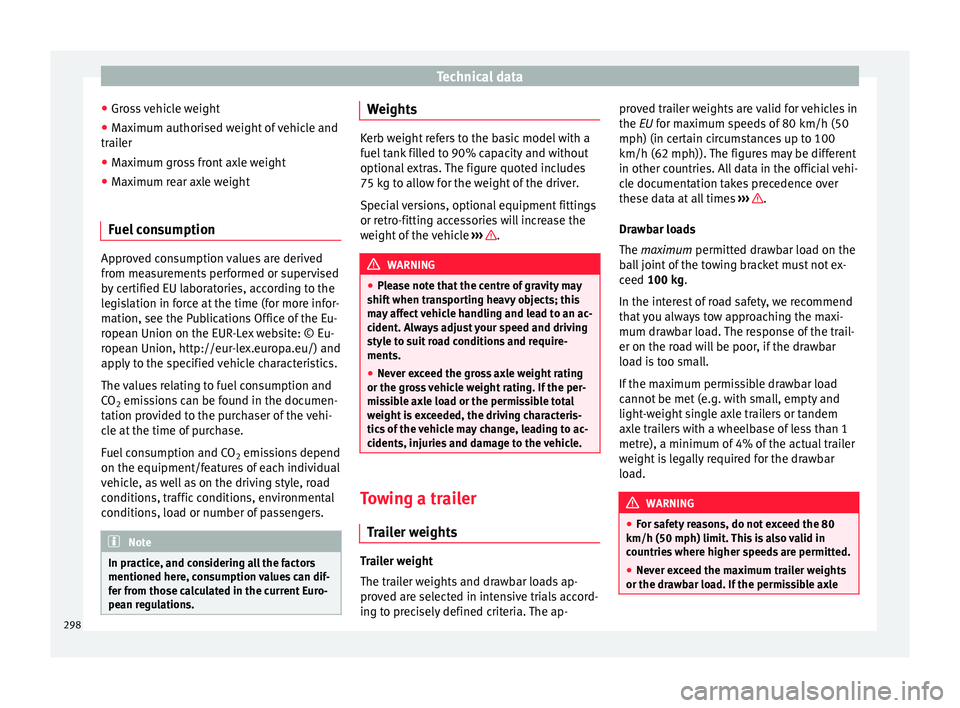
Technical data
● Gr o
s
s vehicle weight
● Maximum authorised weight of vehicle and
trail
er
● Maximum gross front axle weight
● Maximum rear axle weight
Fuel consumption Approved consumption values are derived
from me
a
surements performed or supervised
by certified EU laboratories, according to the
legislation in force at the time (for more infor-
mation, see the Publications Office of the Eu-
ropean Union on the EUR-Lex website: © Eu-
ropean Union, http://eur-lex.europa.eu/) and
apply to the specified vehicle characteristics.
The values relating to fuel consumption and
CO 2 emissions can be found in the documen-
tation provided to the purchaser of the vehi-
cle at the time of purchase.
Fuel consumption and CO 2 emissions depend
on the equipment/features of each individual
vehicle, as well as on the driving style, road
conditions, traffic conditions, environmental
conditions, load or number of passengers. Note
In practice, and considering all the factors
mentioned here, c on
sumption values can dif-
fer from those calculated in the current Euro-
pean regulations. Weights
Kerb weight refers to the basic model with a
fuel
t
ank filled to 90% capacity and without
optional extras. The figure quoted includes
75 kg to allow for the weight of the driver.
Special versions, optional equipment fittings
or retro-fitting accessories will increase the
weight of the vehicle ››› .
WARNING
● Ple a
se note that the centre of gravity may
shift when transporting heavy objects; this
may affect vehicle handling and lead to an ac-
cident. Always adjust your speed and driving
style to suit road conditions and require-
ments.
● Never exceed the gross axle weight rating
or the gros
s vehicle weight rating. If the per-
missible axle load or the permissible total
weight is exceeded, the driving characteris-
tics of the vehicle may change, leading to ac-
cidents, injuries and damage to the vehicle. Towing a trailer
Trai
ler weights Trailer weight
The tr
ai
l
er weights and drawbar loads ap-
proved are selected in intensive trials accord-
ing to precisely defined criteria. The ap- proved trailer weights are valid for vehicles in
the EU f
or maximum speeds of 80 km/h (50
mph) (in certain circumstances up to 100
km/h (62 mph)). The figures may be different
in other countries. All data in the official vehi-
cle documentation takes precedence over
these data at all times ››› .
Dr a
wb
ar loads
The maximum permitted drawbar load on the
ball joint of the towing bracket must not ex-
ceed 100 kg.
In the interest of road safety, we recommend
that you always tow approaching the maxi-
mum drawbar load. The response of the trail-
er on the road will be poor, if the drawbar
load is too small.
If the maximum permissible drawbar load
cannot be met (e.g. with small, empty and
light-weight single axle trailers or tandem
axle trailers with a wheelbase of less than 1
metre), a minimum of 4% of the actual trailer
weight is legally required for the drawbar
load. WARNING
● For s af
ety reasons, do not exceed the 80
km/h (50 mph) limit. This is also valid in
countries where higher speeds are permitted.
● Never exceed the maximum trailer weights
or the drawb
ar load. If the permissible axle298
Page 321 of 324
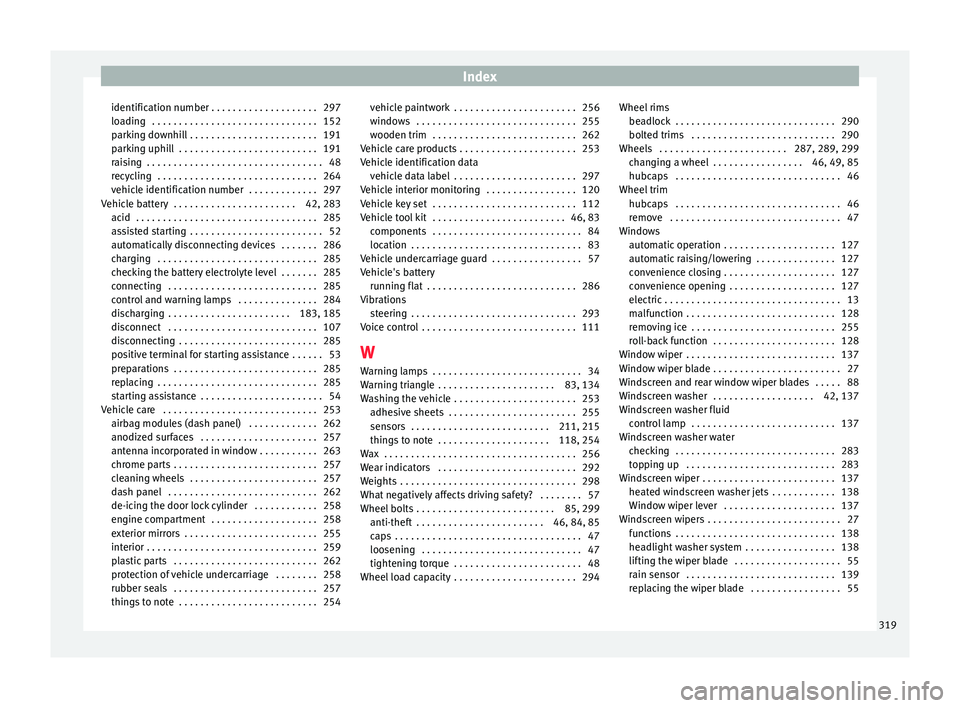
Index
identification number . . . . . . . . . . . . . . . . . . . . 297
lo a
din
g . . . . . . . . . . . . . . . . . . . . . . . . . . . . . . . 152
parking downhill . . . . . . . . . . . . . . . . . . . . . . . . 191
parking uphill . . . . . . . . . . . . . . . . . . . . . . . . . . 191
raising . . . . . . . . . . . . . . . . . . . . . . . . . . . . . . . . . 48
recycling . . . . . . . . . . . . . . . . . . . . . . . . . . . . . . 264
vehicle identification number . . . . . . . . . . . . . 297
Vehicle battery . . . . . . . . . . . . . . . . . . . . . . . 42, 283 acid . . . . . . . . . . . . . . . . . . . . . . . . . . . . . . . . . . 285
assisted starting . . . . . . . . . . . . . . . . . . . . . . . . . 52
automatically disconnecting devices . . . . . . . 286
charging . . . . . . . . . . . . . . . . . . . . . . . . . . . . . . 285
checking the battery electrolyte level . . . . . . . 285
connecting . . . . . . . . . . . . . . . . . . . . . . . . . . . . 285
control and warning lamps . . . . . . . . . . . . . . . 284
discharging . . . . . . . . . . . . . . . . . . . . . . . 183, 185
disconnect . . . . . . . . . . . . . . . . . . . . . . . . . . . . 107
disconnecting . . . . . . . . . . . . . . . . . . . . . . . . . . 285
positive terminal for starting assistance . . . . . . 53
preparations . . . . . . . . . . . . . . . . . . . . . . . . . . . 285
replacing . . . . . . . . . . . . . . . . . . . . . . . . . . . . . . 285
starting assistance . . . . . . . . . . . . . . . . . . . . . . . 54
Vehicle care . . . . . . . . . . . . . . . . . . . . . . . . . . . . . 253 airbag modules (dash panel) . . . . . . . . . . . . . 262
anodized surfaces . . . . . . . . . . . . . . . . . . . . . . 257
antenna incorporated in window . . . . . . . . . . . 263
chrome parts . . . . . . . . . . . . . . . . . . . . . . . . . . . 257
cleaning wheels . . . . . . . . . . . . . . . . . . . . . . . . 257
dash panel . . . . . . . . . . . . . . . . . . . . . . . . . . . . 262
de-icing the door lock cylinder . . . . . . . . . . . . 258
engine compartment . . . . . . . . . . . . . . . . . . . . 258
exterior mirrors . . . . . . . . . . . . . . . . . . . . . . . . . 255
interior . . . . . . . . . . . . . . . . . . . . . . . . . . . . . . . . 259
plastic parts . . . . . . . . . . . . . . . . . . . . . . . . . . . 262
protection of vehicle undercarriage . . . . . . . . 258
rubber seals . . . . . . . . . . . . . . . . . . . . . . . . . . . 257
things to note . . . . . . . . . . . . . . . . . . . . . . . . . . 254 vehicle paintwork . . . . . . . . . . . . . . . . . . . . . . . 256
window
s . . . . . . . . . . . . . . . . . . . . . . . . . . . . . . 255
wooden trim . . . . . . . . . . . . . . . . . . . . . . . . . . . 262
Vehicle care products . . . . . . . . . . . . . . . . . . . . . . 253
Vehicle identification data vehicle data label . . . . . . . . . . . . . . . . . . . . . . . 297
Vehicle interior monitoring . . . . . . . . . . . . . . . . . 120
Vehicle key set . . . . . . . . . . . . . . . . . . . . . . . . . . . 112
Vehicle tool kit . . . . . . . . . . . . . . . . . . . . . . . . . 46, 83 components . . . . . . . . . . . . . . . . . . . . . . . . . . . . 84
location . . . . . . . . . . . . . . . . . . . . . . . . . . . . . . . . 83
Vehicle undercarriage guard . . . . . . . . . . . . . . . . . 57
Vehicle's battery running flat . . . . . . . . . . . . . . . . . . . . . . . . . . . . 286
Vibrations steering . . . . . . . . . . . . . . . . . . . . . . . . . . . . . . . 293
Voice control . . . . . . . . . . . . . . . . . . . . . . . . . . . . . 111
W Warning lamps . . . . . . . . . . . . . . . . . . . . . . . . . . . . 34
Warning triangle . . . . . . . . . . . . . . . . . . . . . . 83, 134
Washing the vehicle . . . . . . . . . . . . . . . . . . . . . . . 253 adhesive sheets . . . . . . . . . . . . . . . . . . . . . . . . 255
sensors . . . . . . . . . . . . . . . . . . . . . . . . . . 211, 215
things to note . . . . . . . . . . . . . . . . . . . . . 118, 254
Wax . . . . . . . . . . . . . . . . . . . . . . . . . . . . . . . . . . . . 256
Wear indicators . . . . . . . . . . . . . . . . . . . . . . . . . . 292
Weights . . . . . . . . . . . . . . . . . . . . . . . . . . . . . . . . . 298
What negatively affects driving safety? . . . . . . . . 57
Wheel bolts . . . . . . . . . . . . . . . . . . . . . . . . . . 85, 299 anti-theft . . . . . . . . . . . . . . . . . . . . . . . . 46, 84, 85
caps . . . . . . . . . . . . . . . . . . . . . . . . . . . . . . . . . . . 47
loosening . . . . . . . . . . . . . . . . . . . . . . . . . . . . . . 47
tightening torque . . . . . . . . . . . . . . . . . . . . . . . . 48
Wheel load capacity . . . . . . . . . . . . . . . . . . . . . . . 294 Wheel rims
beadloc k . . . . . . . . . . . . . . . . . . . . . . . . . . . . . . 290
bolted trims . . . . . . . . . . . . . . . . . . . . . . . . . . . 290
Wheels . . . . . . . . . . . . . . . . . . . . . . . . 287, 289, 299 changing a wheel . . . . . . . . . . . . . . . . . 46, 49, 85
hubcaps . . . . . . . . . . . . . . . . . . . . . . . . . . . . . . . 46
Wheel trim hubcaps . . . . . . . . . . . . . . . . . . . . . . . . . . . . . . . 46
remove . . . . . . . . . . . . . . . . . . . . . . . . . . . . . . . . 47
Windows automatic operation . . . . . . . . . . . . . . . . . . . . . 127
automatic raising/lowering . . . . . . . . . . . . . . . 127
convenience closing . . . . . . . . . . . . . . . . . . . . . 127
convenience opening . . . . . . . . . . . . . . . . . . . . 127
electric . . . . . . . . . . . . . . . . . . . . . . . . . . . . . . . . . 13
malfunction . . . . . . . . . . . . . . . . . . . . . . . . . . . . 128
removing ice . . . . . . . . . . . . . . . . . . . . . . . . . . . 255
roll-back function . . . . . . . . . . . . . . . . . . . . . . . 128
Window wiper . . . . . . . . . . . . . . . . . . . . . . . . . . . . 137
Window wiper blade . . . . . . . . . . . . . . . . . . . . . . . . 27
Windscreen and rear window wiper blades . . . . . 88
Windscreen washer . . . . . . . . . . . . . . . . . . . 42, 137
Windscreen washer fluid control lamp . . . . . . . . . . . . . . . . . . . . . . . . . . . 137
Windscreen washer water checking . . . . . . . . . . . . . . . . . . . . . . . . . . . . . . 283
topping up . . . . . . . . . . . . . . . . . . . . . . . . . . . . 283
Windscreen wiper . . . . . . . . . . . . . . . . . . . . . . . . . 137 heated windscreen washer jets . . . . . . . . . . . . 138
Window wiper lever . . . . . . . . . . . . . . . . . . . . . 137
Windscreen wipers . . . . . . . . . . . . . . . . . . . . . . . . . 27 functions . . . . . . . . . . . . . . . . . . . . . . . . . . . . . . 138
headlight washer system . . . . . . . . . . . . . . . . . 138
lifting the wiper blade . . . . . . . . . . . . . . . . . . . . 55
rain sensor . . . . . . . . . . . . . . . . . . . . . . . . . . . . 139
replacing the wiper blade . . . . . . . . . . . . . . . . . 55
319